Ibike Korea People-to-People Program
 Photo essay: Seonunsa
Photo essay: Seonunsa
Points of Interest: Seonunsa, Chenwangum, Sangdolsalam
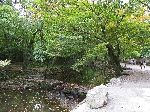
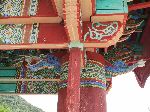
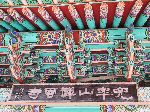
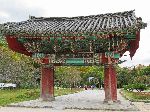
In the classical style, a purifying stream passes by the temple and the entrance path is marked by a one pillar gate.
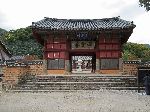
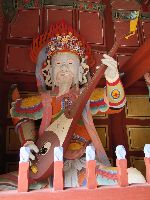
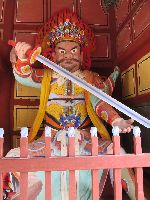
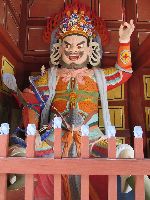
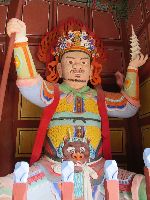
The Chenwangum gate honors the four Devas. Though of Hindu origins, as devotees of Buddha, these figures guard Buddhist cannons and are the protective deities over monks and the faithful. The Jiguk Deva (lute) rules over the east, the Gwangmok Deva (dragon) over the west, the Jeungjang Deva (sword) over the south and the Damun Deva (pagoda) over the north. At the center of the four quarters is Sumisan. Sumisan is where Buddha lives -- a temple is symbolic of Sumisan, therefore, if one passes this gate he or she is likely to enter the world of Buddha.
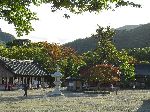
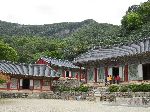
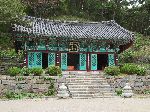
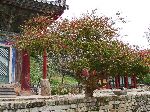

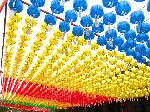 Strolling
the ground of a temple is always engaging. There might be a few parallel lines
and plains, but there usually is a lot more asymmetry, converging and diverging
lines and plains, a variety of textures and colors and a mixture of highly
ornate and purposefully plain.
Strolling
the ground of a temple is always engaging. There might be a few parallel lines
and plains, but there usually is a lot more asymmetry, converging and diverging
lines and plains, a variety of textures and colors and a mixture of highly
ornate and purposefully plain.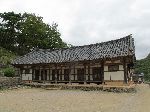

 Sleeping
quarters for the monks (left) are general austere and have none of the color and celebrations
of the shrines.
Sleeping
quarters for the monks (left) are general austere and have none of the color and celebrations
of the shrines.In Mansye-ru pavilion low table are set for study and tea (right) the building is very large and bold, while the tables and settings are very simple.
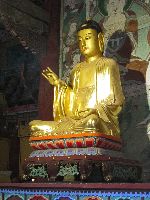
 2.
2.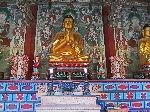 3.
3.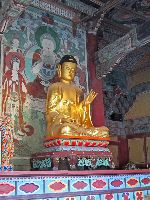
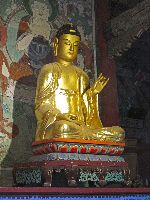
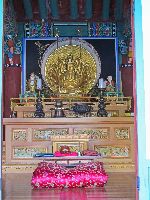
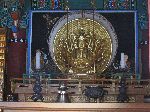 The
multi-media interior of the shrines and sanctuaries demonstrate a dedication to
detail and a mastery of craft -- many crafts. Note that the seated Buddha's and
the Bodhisattva (to the sides) all
show different hand positions indicated that they are demonstrating different
aspects.
The
multi-media interior of the shrines and sanctuaries demonstrate a dedication to
detail and a mastery of craft -- many crafts. Note that the seated Buddha's and
the Bodhisattva (to the sides) all
show different hand positions indicated that they are demonstrating different
aspects.The Bodhisattva is Gwanseeum-bosal (the Bodhisattva of Compassion) from Gwaneeum-jeon (hall). It wears a multi-headed crown and is identified by its many hands.
The three Buddha from the main Temple (row above) are:
1)
Teaching Buddha / DharmaChakra Buddha (“putting the cosmic law of righteousness
in order”)
2)
Buddha of Supreme Enlightenment or Perfection
3) Buddha of (?)

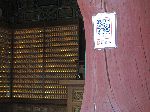 Seonunsa
(temple) offers temple-stays which provide an opportunity to experience a bit of
temple life, including simple dressing in temple clothes. The program also
includes a tour of the temple to learn about the symbolism, philosophy, ritual
and routine of the temple, meals, and in the evening a question and answer
session, often with the Sunim (head monk) if he is available, at which he also makes and serves tea.
Seonunsa
(temple) offers temple-stays which provide an opportunity to experience a bit of
temple life, including simple dressing in temple clothes. The program also
includes a tour of the temple to learn about the symbolism, philosophy, ritual
and routine of the temple, meals, and in the evening a question and answer
session, often with the Sunim (head monk) if he is available, at which he also makes and serves tea.To further help outsiders understand the temple and its contents QR codes have been posted on some of the buildings (right).
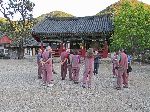

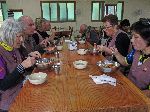
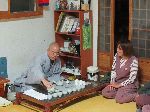



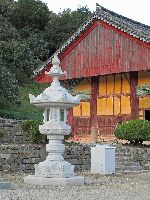 A
stone lantern and stone pagoda are present in the courtyard of almost every
Korea Buddhist temple. The lantern were made to figuratively and literally remove the darkness
within temples where Buddha rested -- to shed light and knowledge on those who
come there.. Because lanterns are connected to the
offering of lanterns for Buddha, they are usually located in front of the main
sanctuary. They are often seen in tandem with stone pagodas representing Buddha.
A
stone lantern and stone pagoda are present in the courtyard of almost every
Korea Buddhist temple. The lantern were made to figuratively and literally remove the darkness
within temples where Buddha rested -- to shed light and knowledge on those who
come there.. Because lanterns are connected to the
offering of lanterns for Buddha, they are usually located in front of the main
sanctuary. They are often seen in tandem with stone pagodas representing Buddha.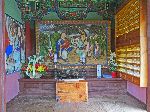
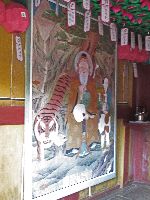
In what is a fusion of Buddhism and local traditional religion, Sanshin-gak, the highest temple in the compound houses, the altar for Sanshin, the Mountain Spirit who manages the mountain and Guksa, the great god guarding a Buddhist temple. It can usually be identified by the tiger in the imagary.
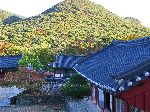
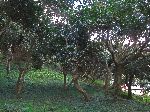
Behind the temple is it famous hillside forest of red camellia trees. They bloom in the early March. The trees are believed to be between 500-600 years old. These flowers frequently appear in literature amd are designated as Natural Monuments. Seonunsa temple is also known for its beautiful surroundings throughout the year: In the spring there are also cherry blossoms; in the summer sangsa flowers decorate the road to the Dosoram area; fall leaves and winter sceneries are beautiful as well.

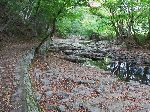
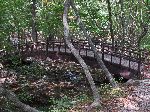
 Because
of its beauty thousands of people come to walk along Dosol streams and in the
mountains behind the temple. There are dozens of kilometers of trails that provide a
calm environment for meditative walks, or strenuous hikes, as might be desired.
Because
of its beauty thousands of people come to walk along Dosol streams and in the
mountains behind the temple. There are dozens of kilometers of trails that provide a
calm environment for meditative walks, or strenuous hikes, as might be desired.
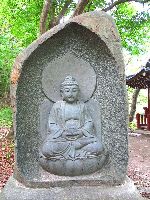
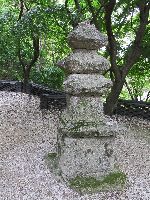
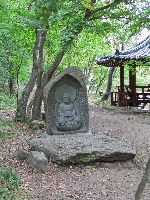 Scattered in the hills are shrines, art
works, stupa, memorials, meditation retreat centers and historic
locations. The impact of the pieces is the
combination of the craftsmanship itself and the setting. Generally specific
information on specific pieces is hard to come by.
Scattered in the hills are shrines, art
works, stupa, memorials, meditation retreat centers and historic
locations. The impact of the pieces is the
combination of the craftsmanship itself and the setting. Generally specific
information on specific pieces is hard to come by. 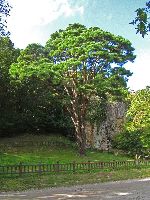
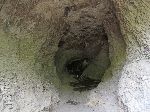 The
Jinheunggul (cave) (left) is famous for being a
location where Shilla King Jinheung (r. 540-575) received some spiritual
training, and its role in contemporary historic television dramas. King Jinheung
is remembered for expanding his kingdom and being the greatest king of Shilla.
In 551, he allied with King Seong of Baekje to take the Han River Valley from
the Goguryeo. The spoils were then dividing it equally. In 553, King Jinheung
turned and attacked the exhausted army of the Baekje and claimed the entire
valley for themselves.
The
Jinheunggul (cave) (left) is famous for being a
location where Shilla King Jinheung (r. 540-575) received some spiritual
training, and its role in contemporary historic television dramas. King Jinheung
is remembered for expanding his kingdom and being the greatest king of Shilla.
In 551, he allied with King Seong of Baekje to take the Han River Valley from
the Goguryeo. The spoils were then dividing it equally. In 553, King Jinheung
turned and attacked the exhausted army of the Baekje and claimed the entire
valley for themselves.Jinjeunggul is deep in Baekje territory, and so far we have found no date for when he spent time here.
Jangsasong, the pine tree (right) next to Jinjeunggul, is significant for being an old tree -- estimates are 600 years old.
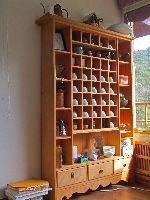

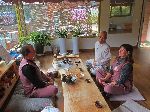
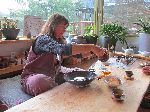
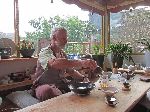
During a meditative walk, a monk at Dosol-am invited us in for tea. Besides his graciousness, he insisted that we each take a turn serving tea. As we each took our place, without language, he patiently, but firmly conveyed the proper posture and ritual for serving tea.
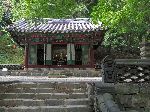

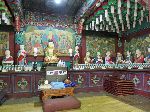
 Arahanjeon houses the statue
of Arahan, a saint who has the highest position of monks of Hinayana
Buddhism. According to legend, a giant snake in Yongmun cave at Dosol-am
was terrorizing the villagers. In an attempt to protect themselves, the
villagers brought a Arahan stature from India and placed it here. The
snake disappeared. The villagers then built this shrine to make certain
that the snake did not reappear. The present building was built near the
end of the Joseon dynasty.
Arahanjeon houses the statue
of Arahan, a saint who has the highest position of monks of Hinayana
Buddhism. According to legend, a giant snake in Yongmun cave at Dosol-am
was terrorizing the villagers. In an attempt to protect themselves, the
villagers brought a Arahan stature from India and placed it here. The
snake disappeared. The villagers then built this shrine to make certain
that the snake did not reappear. The present building was built near the
end of the Joseon dynasty.
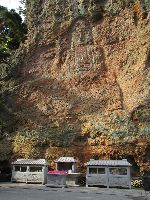

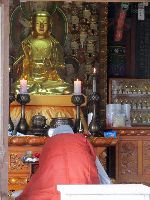 Looming
over the trail is Dolsalam (stone man) cliff with a giant Maaebul, rock carving of Buddha (photos to the
left). It is believed to be Maitreya and dates to the Goryeo dynasty. The
giant seated Buddha is 3.3m above the ground, and is 15.6m tall and 8.5m wide.
Looming
over the trail is Dolsalam (stone man) cliff with a giant Maaebul, rock carving of Buddha (photos to the
left). It is believed to be Maitreya and dates to the Goryeo dynasty. The
giant seated Buddha is 3.3m above the ground, and is 15.6m tall and 8.5m wide.
A long stairway to the right of the giant Buddha lead up to a small and popular shrine at the top of the rock. This is one of the most important shrines of Seonunsa.

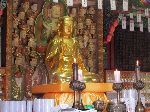
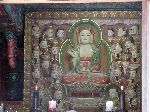 The shrine is called Sangdolsalam (top of stone man). It contains Jijang
Bodhisattva
(Ksitigarbha) who is said to rescue people from suffering. Unlike the typical
Jijang Bodhisattva, it wears a hood, which was in vogue during the Goryeo
dynasty. The shines significance is reflect in a steady stream of believers who
come here and climb the mountain to pay their respects. Though the shrine is
said to have existed since the Tongil-Silla period, the present building was
rebuilt at the beginning of the Joseon Dynasty and has been repaired several
times. In 2015, the statue of the golden Bodhisattva (right) was removed,
revealing a tapestry of the same saint.
The shrine is called Sangdolsalam (top of stone man). It contains Jijang
Bodhisattva
(Ksitigarbha) who is said to rescue people from suffering. Unlike the typical
Jijang Bodhisattva, it wears a hood, which was in vogue during the Goryeo
dynasty. The shines significance is reflect in a steady stream of believers who
come here and climb the mountain to pay their respects. Though the shrine is
said to have existed since the Tongil-Silla period, the present building was
rebuilt at the beginning of the Joseon Dynasty and has been repaired several
times. In 2015, the statue of the golden Bodhisattva (right) was removed,
revealing a tapestry of the same saint. Behind
Sangdolsalam is a shine to the traditional Korean mountain god. These often
fairly easy to identify because of their high position and the presence of two
shaman and a tiger.
Behind
Sangdolsalam is a shine to the traditional Korean mountain god. These often
fairly easy to identify because of their high position and the presence of two
shaman and a tiger.There is also a great view from Sangdolsalam (photos below) and some cute chipmunks packing their cheeks for winter.
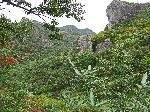
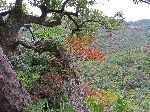
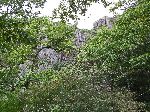
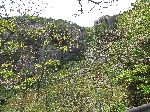
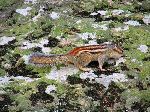
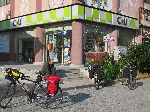
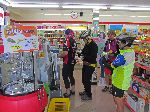
For those who find the rigors and austerity of temple life too sever, within a hundred meters of the entrance is a convenience story that sells coffee and all varieties of junk-, or perhaps it is comfort- food.
 Please
contact us if you would like to be added to
Ibike's mailing list or have questions, comments, corrections or criticism. (Also, please let us know how you learned about us and
found this site.) Privacy policy.
Please
contact us if you would like to be added to
Ibike's mailing list or have questions, comments, corrections or criticism. (Also, please let us know how you learned about us and
found this site.) Privacy policy.
![]() IBF Homepage
IBF Homepage ![]() Ibike Programs
Ibike Programs
![]() Ibike Schedule
Ibike Schedule
![]() Search
Search



